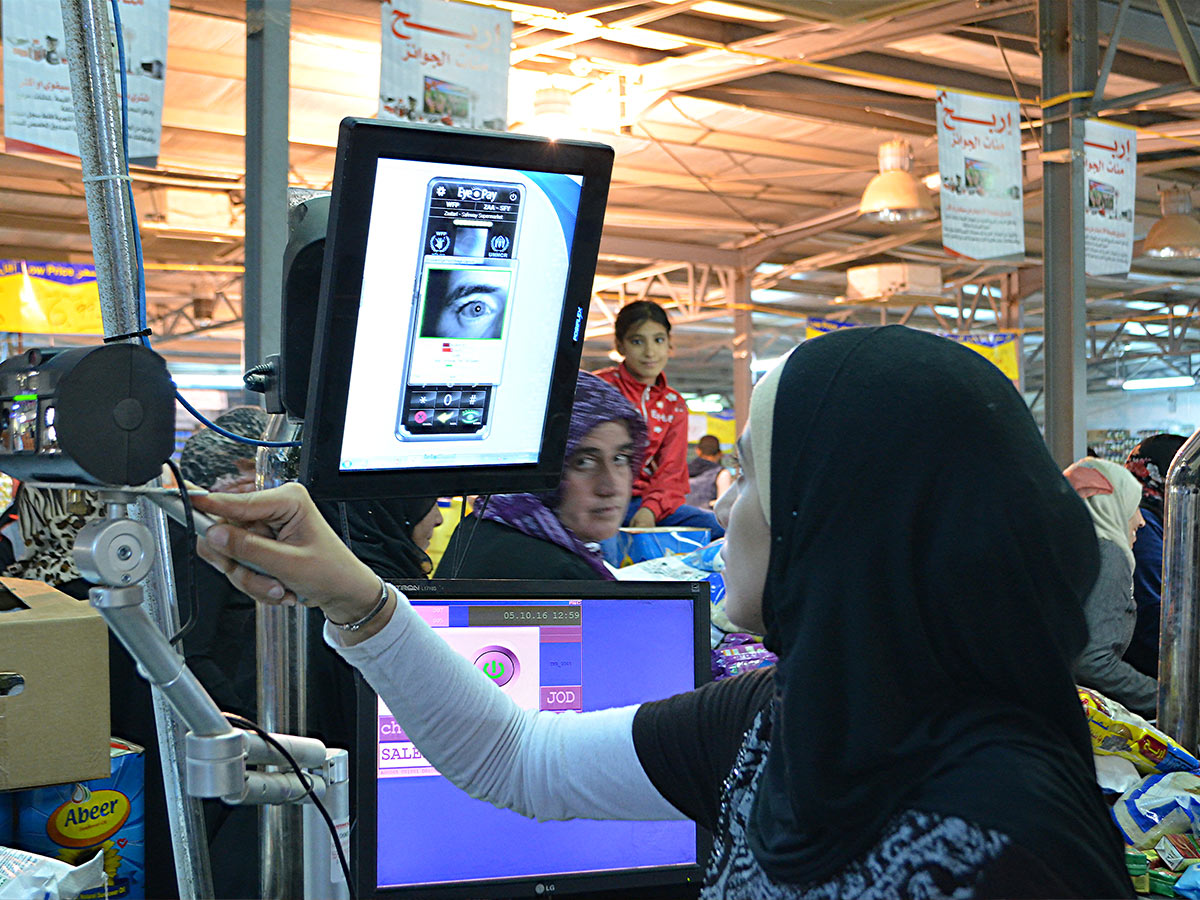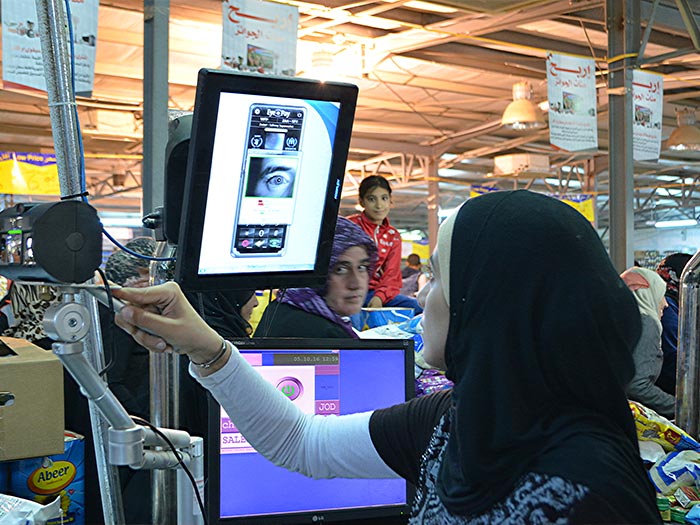
Blockchain: 4 powerful ways it is making a difference in the world
 Through its Blockchain for Food initiative, the World Food Programme, in partnership with the UNHCR, is using blockchain technology and biometrics iris scans to assist refugees with food purchases (World Food Programme/Shaza Moghraby)
Through its Blockchain for Food initiative, the World Food Programme, in partnership with the UNHCR, is using blockchain technology and biometrics iris scans to assist refugees with food purchases (World Food Programme/Shaza Moghraby)
When you hear the word blockchain, things like early virus detection, vaccine distribution, refugee identification, sustainable mining and emergency food delivery may not come to mind.
But that’s exactly what the technology is being used for today—including helping to fight the COVID-19 pandemic. It’s a phenomenon with a name—Blockchain for Social Impact—and it’s breaking ground (there’s even a coalition and an annual conference). From corporations to governments to international agencies to local charities, blockchain’s potential is being realized, shifting how industries—including finance, health care, aid and agriculture—operate.
Here are four ways blockchain is proving to be most powerful.
1. EFFICIENT DATA MANAGEMENT
When it comes to data, blockchain’s transparent digital ledger technology prevails on many fronts, including security, analysis, traceability and sharing.
When using blockchain technology, information entered is stored as individual transactions that reside on one or more nodes in the blockchain network. Each node stores a copy of the whole blockchain making it difficult to compromise the data, while providing an added barrier against breaches. Transactions on the blockchain can be tracked and monitored, making it easy to trace unauthorized changes.
Any new information entered is analyzed and verified in near real-time, and stored as a new transaction, which improves data quality while also allowing for simultaneous collaboration on the same sets of data.
Traceability-wise, blockchain technology uniquely identifies each transaction with a token, creating a historical chain of events. In a private blockchain, access to the transactions on the blockchain can be restricted while transactions on a public blockchain can be viewed by anyone.
Being decentralized, blockchain also breaks ground, as it is more resistant to tampering, with no single point of attack. Government, agencies and organizations can share data more transparently with all participating nodes or agents having access to the full chain, with hashing (or transaction) verification that can be conducted by all members instead of one party.
Furthermore, “individuals can give the organization the authority to read or edit certain fields, and they can share certain information with other agencies. The organization can be given permission to write data, but the user retains ultimate control,” the Association for Intelligent Information Management (AIIM) shares in a recent blog.
HOW IT WORKS IN THE REAL WORLD
COVID-19 has brought about new efforts to use blockchain in the fight against the pandemic.
MiPasa—a collaborative effort between IBM, the World Health Organization (WHO), the Center for Disease Control (CDC) and other global health professionals, software developers and privacy experts—is an open blockchain platform that aims to amalgamate, analyze and validate COVID-19 data from various sources, identifying and addressing any inconsistencies, errors or misreporting.
Using three types of validation—including reconciliation of disparate data sources such as WHO and CDC figures; ensuring new data matches the original; and validation from the public reporting inconsistencies or bad information—the project aims to provide reliable, quality data to evoke analysis and response from appropriate players.
2. TRANSPARENCY OF FOREIGN AID
Blockchain allows transactions—be they cash, records or products—to be viewed in real time from starting point to destination. Money trails are fully transparent, tracked and monitored.
This could drastically improve efficiencies in the philanthropic and aid sectors, experts say. According to the Organisation for Economic Co-operation and Development (OECD), 30 per cent of the approximate US$150 billion spent annually on global aid is lost to corruption. That’s a lot of aid dollars in transit.
“With aid dollars all of a sudden being moved via a blockchain, you would now have US$50 billion accounted for, and available for use,” says Doug Galen, CEO and co-founder of RippleWorks Foundation, and author of the Stanford Graduate School of Business report, Blockchain for Social Impact 2019.
Historically, there is limited ability to track funds sent from organizations, agencies and governments, particularly when working in complicated regions, adds Ric Shreves, director, emerging technology at Mercy Corps, and author of the report: A Revolution in Trust: Distributed Ledger Technology in Relief and Development.
“The money flows can be quite complex,” he says. “There will always be places we work where things are done in very basic ways because that’s the only way they can be done reliably … but that doesn’t mean there aren’t situations where [blockchain] technology is applicable.”
HOW IT WORKS IN THE REAL WORLD
From a supply management standpoint, car manufacturers Volkswagen and Ford, and tech giant IBM—in partnership with battery producer LG Chem, mining giant Huayou Cobalt and sourcing specialists RCS Global Group—are using blockchain to ethically source cobalt in the Democratic Republic of Congo. IBM’s blockchain platform and the Linux Foundation’s Hyperledger Fabric tracking software traces cobalt used to manufacture electric vehicle (EV) batteries, in near real time from mining to end-user, as it moves through the supply chain, while ensuring all processes meet RCS global responsible sourcing standards, developed by the OECD. They’ve also committed to operating in zones free from conflict or child labour also aligned with OECD standards.
3. DIGITAL IDENTITY CREATION
Digital identity is another area where blockchain could have great impact, according to experts. With 79.5 million forcibly displaced people worldwide at the end of 2019, and 1.7 billion without access to a bank account (as of 2017), many struggle to not just meet daily needs, but identify themselves and rebuild their lives.
“Most of us in places like the U.S., we are trying to reduce our identity footprint. We don’t want everyone to know about us. That’s actually a privilege,” says Galen. “In many emerging markets, people without an identity can’t enter the formal working market. They can’t enter the banking world … blockchain is a way to build up digital identity.”
HOW IT WORKS IN THE REAL WORLD
Blockchain—combined with biometrics and cryptocurrency—is helping refugees identify themselves, purchase food, and receive health care, including vaccinations.
For example, in partnership with the United Nations High Commissioner for Refugees (UNHCR), the World Food Programme identifies refugees using biometric iris scans and distributing digital tokens instead of vouchers for food purchases.
Blockchain could also help aid organizations working in the same regions to deliver their services more efficiently, while avoiding duplication of efforts, says Shreves.
“With a shared distributed ledger, we could on-board that beneficiary once and share that information across all of the participants,” he adds. “Getting that 360-degree view of aid that any beneficiary has received has always been an extremely allusive target.
“This technology isn’t going to solve all the problems, but it would move us a step closer to that sort of thing.”
4. VISIBILITY INTO FUNDRAISING
These days, donors want to know the impact of their dollars before supporting a charity. According to a Fidelity Charitable survey, 41 per cent of donors say they have changed how they give due to increased knowledge about nonprofit effectiveness.
Blockchain opens the door to fundraising, allowing organizations to receive and track funds more efficiently via a ledger and cryptocurrency. It also gives donors more insight into where and how their dollars are being spent, through tracking the movement of funds from donor to charity to field teams to beneficiaries, explains Shreves.
“The ability to create an immutable, transparent, shared ledger opens up a great number of possibilities for improving the transparency of the flow of funds in donation and aid situations,” he says.
This, Galen adds, has the potential to reduce administration costs, including programmatic, financial audit, and monitoring and evaluation expenses, as well as allowing organizations to identify issues and course correct sooner.
“[Those costs] tend to be quite substantial for programs, so if you can drop those a couple of per cent, that’s more money we can put directly towards impact and improving people’s lives,” he says.
HOW IT WORKS IN THE REAL WORLD
Grassroots charities—including Venezuela’s eatBCH and Toronto-based Coins 4 Clothes—have evolved fundraising efforts with blockchain and cryptocurrency. eatBCH uses bitcoin donations to purchase food from local vendors in regions where it works, which is then distributed throughout the respective communities. Meanwhile, Coins 4 Clothes allows donors to earn bitcoin for used clothing donations (temporarily on hold due to COVID-19) made to one of its approved Canadian charities. All BCH donations can be viewed on a blockchain browser, accessed via the organization’s financial page, with donors also submitting photo proofs of their donations, and then shared on eatBCH’s social media pages.
BACK TO BUSINESS
For further insight into how blockchain is being used to innovate business, look to CPA Canada’s report, Perspectives on blockchain from thought leaders in technology, governance, and business. Learn more about blockchain and crypto-assets with our free resources for CPAs.